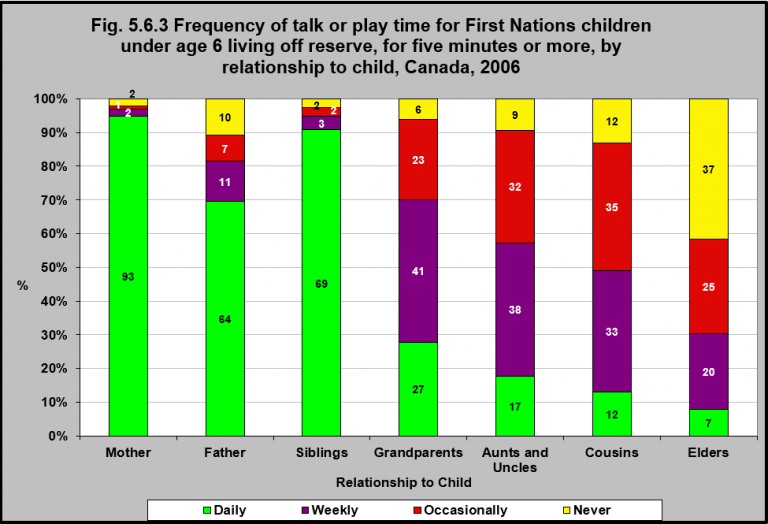Frequency of talk or play time for First Nations children under age 6 living off reserve, for five minutes or more, by relationship to child, Canada, 2006

Notes:
Percents may not add up to 100 because responses of ‘don’t know’, ‘refusal’ and ‘not stated’ were included in the calculation of all estimates and rounding. Additionally, ‘not stated’ and ‘not applicable’ responses were removed.
The category “Mother” includes birth mother, step mother (including common-law step parent), adoptive mother and foster mother.
The category “Father” includes birth father, step father (including common-law step parent), adoptive father and foster father.
Source: CICH graphic created using data adapted from Statistics Canada, Aboriginal Children’s Survey, 2006. http://www.statcan.gc.ca/pub/89-634-x/2008005/t/6000023-eng.htm -accessed August 22, 2017.
In 2006, 93% of First Nations children under age 6, living off reserve, spent five minutes or more talking or playing with their mothers every day and 64% did that with their fathers.
Less spent five minutes or more talking or playing daily with grandparents (27%), Aunts/Uncles (17%), Cousins (12%) and Elders (7%).
However, 41% of First Nations children under age 6 living off reserve spent five minutes or more talking or playing with grandparents weekly and 20% had this weekly interaction with Elders.
Implications
Indigenous cultures have traditionally valued kin, the interconnection of family, and non-family community members in the care and socialization of their children.1 There is also an abiding respect for Elders for their wisdom, spiritual leadership, and role they play in the sharing and preserving social values and beliefs, history, Indigenous knowledge and traditions. While family life has undergone enormous changes over the past 50 years in both Indigenous and non-Indigenous families in Canada, the importance of extended family to Indigenous peoples often stand in contrast to the more traditional nuclear family setting of mainstream Canadian society.2 These differing perspectives must be taken into account in the design and adaptation of community services for Indigenous peoples.
1Muir, N., & Bohr, Y. (2014). Contemporary practice of traditional Aboriginal child rearing: A review. First Peoples Child & Family Review, 9(1), 66-79.
2Brant Castellano, M. (2002). Aboriginal family trends: Extended families, nuclear families, families of the heart. Toronto, ON: The Vanier Institute of the Family. Retrieved October 7, 2017 from http://www.urbancentre.utoronto.ca/pdfs/elibrary/VIFAboriginal.pdf
